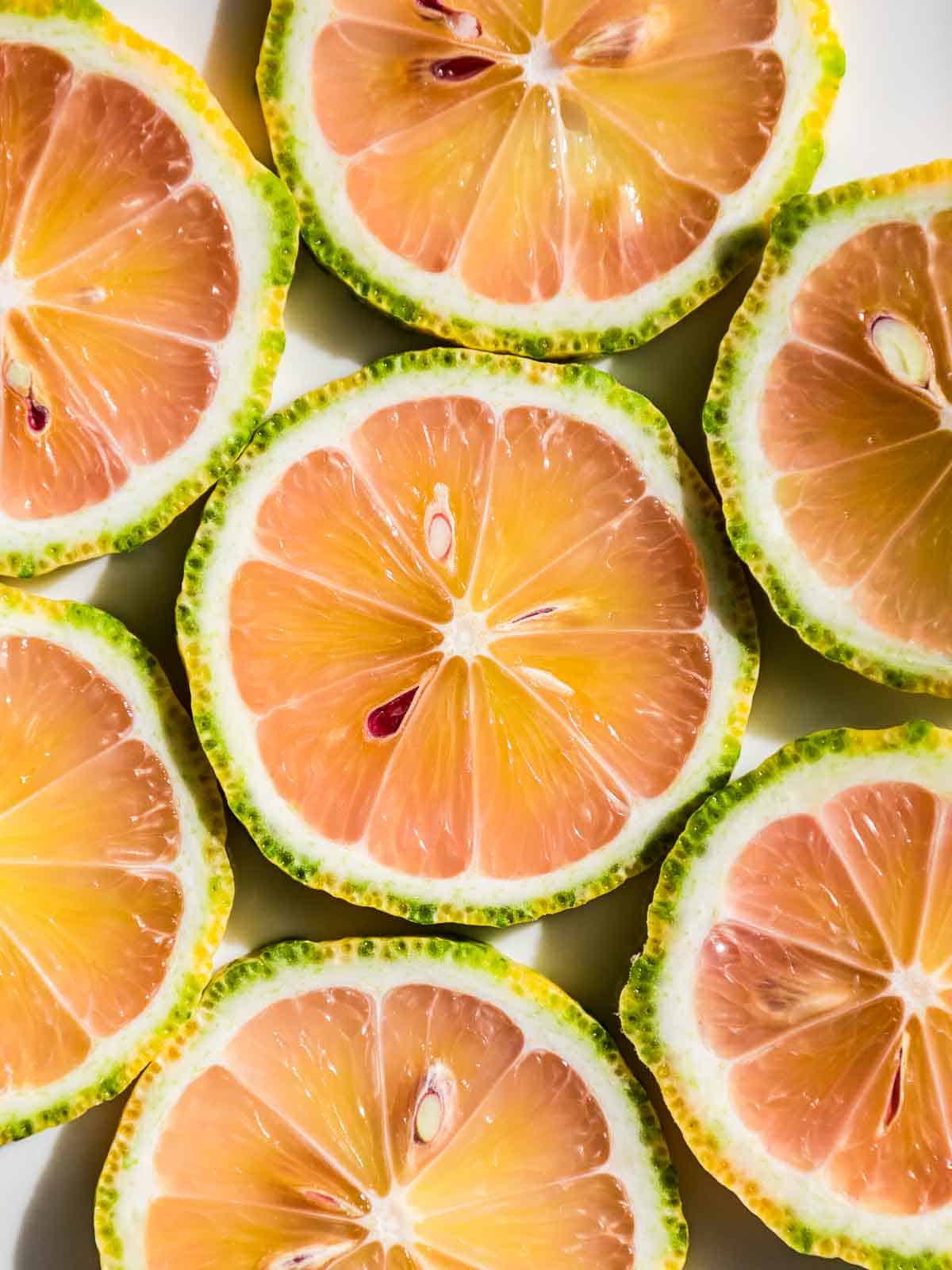List of pink-colored fruits that are actually pink. Including pictures, names, fun facts, and uses in cooking! From common pink fruits to ‘exotic’ fruits, I got you!🩷
10 Common Pink Fruits
1. Pink Lady Apple

Fun fact(s): Pink Lady apples are trademarked and must meet specific sweetness and firmness criteria. As with most apples, they have white flesh inside!
Uses: Pink Lady apples are great in salads, baking, or simply as a crunchy snack. They’re also great toppings for this apple overnight oats!
2. Fuji Apple

Fun fact(s): Fuji apples are one of the sweetest apple varieties, with high natural sugar content.
Uses: Fuji apples are ideal for eating raw, incorporated into baked goods, or as a substitute for Korean pear/applesauce in Korean bulgogi tofu.
3. Redlove Apple

Fun fact(s): Redlove apples are developed in Switzerland. And although they look and sound really pretty with their stunning red/pink flesh, they taste quite sour.
Uses: They are best used raw (or cooked lightly, like in my apple galette) to keep their beautiful color!
4. Red Bartlett Pear

Fun fact(s): Red Bartlett pears are one of the juiciest pear varieties and it has a buttery texture.
Uses: These pears work well in desserts, poached, or sliced into salads for a pop of sweetness.
5. Peach

Fun fact(s): Peaches are native to China and symbolize longevity in Chinese culture. They also have a pale yellow/white-ish flesh, which is why it is included in my white fruits list!
Uses: Peaches are great for cobblers, salads, or grilled for a caramelized, juicy treat. They’re also great simply eaten raw, so you don’t even have to cook them!
6. Donut or Saturn Peach

Fun fact(s): Saturn peaches are named for their flat, disk-like shape resembling Saturn’s ring!
Uses: These peaches are perfect for fresh snacking, adding to fruit salads, or blending into smoothies.
7. Fig

Fun fact(s): Figs are among the first cultivated crops, even before grains were first cultivated! You can read more about it in this NPR article!
Uses: Figs add natural sweetness to salads, desserts, and jams. They’re also great eaten on their own and as toppings in smoothie bowls!
8. Red Grapes

Fun fact(s): There are more than 8,000 grape varieties and they come in various colors from pink, red, green, and black (like in my black fruits list)!
Uses: They’re great when eaten fresh as snacks, dipped into chocolate, or in salads.
9. Pink Reliance Grapes

Fun fact(s): Pink Reliance grapes have light pink skin. They are seedless and known for their floral sweetness.
Uses: Similar to red grapes, these pink grapes are perfect for snacking, salads, or even roasted!
10. Pink Plums

Fun fact(s): There are over 2,000 varieties of plums grown worldwide, ranging in color from yellow and green to deep purple and even black, each with its own unique flavor and texture! You can check out more varieties in my brown fruits and black fruits lists!
Uses: Use them in jams, pies, other desserts, or even savory dishes like roasted or turning them into sauces!
5 Pink Citrus
1. Pink Pomelo

Fun fact(s): Pink pomelos can weigh up to 4 pounds (2 kilograms). With their orange-pinkish flesh, they also made it to my List of Orange Fruits!
Uses: Pomelos are often used in Asian cooking, with Thai pomelo salad being a popular one. They also symbolize good fortune in Chinese culture, which is why you often see them around Lunar New Year.
2. Pink Grapefruit

Fun fact(s): Grapefruits are a natural hybrid of pomelo and mandarin orange (source: Tasting Table).
Uses: Use them raw as snacks, in salads, or broiled to caramelize and bring out their sweetness more!
3. Pink Lemon

Fun fact(s): Most pink lemons have a yellow-and-green striped rind & skin with pink flesh inside. However, there are other varieties with light pink/orange skin like in the picture above.
As they ripen, their pink hue intensifies. So pretty!
Uses: Use them the same way you would use your regular lemons. So for instance, in this spicy eggplant or in this olive soup!
4. Cara Cara Navel Orange

Fun fact(s): Cara Cara oranges are a type of navel orange with pinkish-red flesh. Taste-wise, they’re sweeter and less acidic than regular oranges.
Uses: Use them the same way you would use oranges, so in salads, juices, desserts, snacks, or incorporated into sauces like in my orange aioli!
5. Blood Orange

Fun fact(s): Blood oranges have a taste that combines citrusy sweetness with hints of raspberry!
Uses: Blood oranges are perfect for cocktails (or mocktails), marmalades, or in desserts like in my orange chocolate mousse!
Enjoying this list? I bet you’d like my List of Pink Veggies to complement this! I promise there are also STUNNING pictures there!
4 Pink Tropical Fruits (That Are More Common)
1. Watermelon

Fun fact(s): Watermelons consist of 92% water, making them incredibly hydrating. I remember seeing stalls selling whole watermelons cut open as snacks in Malaysia, sold per fruit and not slices, and I was shocked!
I was like, who would be able to finish the whole thing?? But once I tried it, the watermelons were quite easy to munch on!
Uses: Enjoy fresh, blend into drinks and desserts, or grilled for a smoky flavor. Note that the watermelon rinds are also edible and you can make pickles or Korean banchan from them!
2. Passion Fruit

Fun fact(s): The most eaten part of passion fruit is its orange seeds which are juicy and have a unique and delicious crunch!
Uses: Scoop the pulp into smoothies, drinks, desserts, or even salad dressings for a tropical twist!
3. Red Mango

Fun fact(s): The term “pink/red mango” often refers to mango varieties with pinkish or reddish skin, such as the Tommy Atkins or Palmer mango.
Uses: Mangoes are great for making mango sushi rolls, made into sweet sauce (which you can use either for sushi or in mango green tea latte), or as a decoration in this christmas sushi platter!
4. Prickly Pear (Cactus Pear/Cactus Fruit)

Fun fact(s): Prickly pears come in vibrant shades of green, pink, red, or yellow!
Uses: Use prickly pear in jams, jellies, or to flavor cocktails and syrups.
6 Pink ‘Exotic’ Fruits
Just to clarify, I use the word “exotic” here to denote that these fruits originate outside the West. According to its definition of “unusual and exciting because of coming (or seeming to come) from far away, especially a tropical country”, what’s exotic to you might be different than what’s considered exotic by people living in the tropics!
1. Pink Dragon Fruit

Fun fact(s): Pink dragon fruit, also called pitaya, grows on a cactus and thrives in tropical climates, which is why they are very popular in Bali! It has a spiky skin (which btw, does NOT pierce through) and tiny black seeds inside, which are edible and add a very interesting texture to the fruit!
Uses: Blend this bright hot pink fruit into smoothies, make vibrant smoothie bowls, or enjoy it fresh with a squeeze of lime! I promise the bright pink/magenta color will brighten your day!☀️
2. Pink Guava

Fun fact(s): Pink guavas have green skin and pink flesh inside. The entire guava fruit, including the skin and seeds, is edible. No waste!
Btw, there are also guavas that have white flesh, which you can read more in my white fruits list!
Uses: Add them to fruit salads, make guava juice, or turn them into jams and jellies. In Indonesia where I come from (where there is also an abundance of pink guavas), there is a very popular guava juice that I like to get on my flight back home!
3. Rose Apple

Fun fact(s): Despite the name, rose apples are not related to apples and in fact, more related to guavas than apples! Rose apples could help control diabetes, and improve immunity, heart health, and digestion (source: WebMD).
Uses: Enjoy them fresh as a hydrating snack or chop them into fruit salads. In Indonesia where this fruit is popular, they are often made into asinan (fruit pickled side dish)!
4. Lychees

Fun fact(s): Lychees are native to China and they are rich in vitamin C, copper, and potassium! (source: Healthline)
Uses: They are great in desserts, Asian fruit dessert soups, and in drinks!
5. Red Bananas

Fun fact(s): Red bananas contain more vitamin C and fiber while they are lower in terms of glycemic index, when compared to regular yellow bananas! (source: Medicine Net)
Uses: Use them the same way you would use yellow bananas! For yummy and easy breakfast recipes, try these granola cups, Nutella smoothies, or acai breakfast bowls. If you prefer dessert, try these banana spring rolls (inspired by Filipino turon), banana chocolate mousse, or hazelnut mousse!
6. Mangosteen

Fun fact(s): Mangosteen is nicknamed the “queen of fruits” and is native to Southeast Asia.
Uses: Enjoy fresh as a dessert fruit, or use in sorbets and smoothies.
8 Pink Berries
1. Pomegranate

Fun fact(s): Pomegranates are considered a symbol of fertility and abundance in many cultures! You can read more about its cultural symbolism in this article published in the National Library of Medicine.
Uses: Sprinkle these bright pink/magenta pomegranate seeds on salads, yogurt (or vegan quark), and your berries overnight oats. You can also make pomegranate juice which you can use in sauces, cocktails, or smoothies!
2. Cranberries

Fun fact(s): Cranberries are one of the few fruits native to North America.
Uses: A classic for Thanksgiving, cranberry sauce is a must during this holiday! If you have leftovers, make cranberry mayonnaise after Thanksgiving. Or for more generic recipes, use them to make juices and baked goods!
3. Raspberries

Fun fact(s): Raspberries are one of the fruits that go bad the quickest, with a shelf life of just a few days after picking. So definitely try to finish them as soon as you can!
Uses: Add fresh raspberries to desserts like pies, chocolate tarts, or cakes. You can also use them in savory dishes like vinaigrettes, raspberry chipotle sauce, or this raspberry cream cheese dip!
4. Sampinit (Wild Raspberries)

Fun fact(s): Sampinit grows wild in the Philippines, often in mountainous areas. It tastes similar to raspberries, but usually a tad bit more tart.
Uses: Sampinit is often made into jams, syrups, and beverages.
5. Pink Strawberries (Pineberries)

Fun fact(s): Pineberries are a unique variety of white strawberries with a flavor that people often describe as a blend of pineapple and strawberry.
Uses: Use them the same way you would use regular red strawberries. So fresh as a snack, dipped into chocolate similar to these chocolate dipped grapes, as toppings for yogurt (or quark for a German version), or made into strawberry oat milk.
6. Cherries

Fun fact(s): There are more than 1000 cherry varieties worldwide, though only a very small percentage of them are commercially cultivated (source: Mental Floss).
Uses: Use them in pies, tarts, and jams. You can also incorporate them into savory dishes by making cherry sauce. I’ve also tried Hungarian cherry soup which a friend of mine made, and it was really good!
7. Jamaican Cherries

Fun fact(s): Jamaican cherries (also known as Singapore cherries, ceri kampung, strawberry tree, or other local names) are not cultivated commercially, but they are still popular in many tropical countries! (source: Specialty Produce)
Uses: Jamaica cherries are often enjoyed fresh, added to teas, or used in jams, desserts, and salads. Their leaves can also be brewed into medicinal tea!
8. Gooseberries

Fun fact(s): Gooseberries can be pink, red, white, green, yellow, or even black! (source: Britannica) This is also why gooseberries are included in my list of black fruits!
Uses: Use gooseberries in baked goods like pies, crumbles, or tarts. As is the case with most berries, you can also make them into jams and jellies!
4 Bonus Pink Fruits!
I don’t have the pictures for these but I thought these are worth a mention!
1. Pink Pearl Apple
Fun fact(s): Pink pearl apples have green skin with a striking pink flesh. So pretty!
Uses: Use them the same way you would use regular apples. So think of raw as snacks, baked goods, salads, etc!
2. Pink Pineapple
Fun fact(s): Pink pineapples (which is usually the patented variety called Pinkglow), are considered a luxury fruit, often marketed as a premium item.
Uses: Serve them raw and uncooked to preserve their bright color! So try incorporating them into this fancy 15-minute pineapple dessert, smoothies, and salsas!
3. Lilly Pilly Berries
Fun fact(s): Native to Australia, lilly pilly berries are small and round to oval berries of about 1 to 2 centimeters in length. The fruit’s taste will change, depending on the variety of the berries.
Uses: Similar to most berries, lilly pilly berries can be used fresh in salads and drinks, cooked into jams, sauces, and baked goods, or infused into beverages like cocktails, smoothies, and even homemade wines! (source: Specialty Produce)
4. Chinese Bayberries
Fun fact(s): Chinese bayberries, also called yangmei, are a popular fruit in East Asia with a sweet-tart flavor.
Uses: Simply infuse them in teas, or incorporate them into baked goods!

FAQ
Want More of This?
If you like this post, pick a color and hit the button below!
25 Pink Vegetables🩷, 30 Purple Vegetables💜, or 17 Blue Vegetables💙, 25 Red Vegetables❤️, 30 Orange Vegetables or 30 Orange Fruits🧡, 20 Yellow Vegetables💛, 35 White Vegetables or 30 White Fruits🤍, 33 Black Vegetables or 30 Black Fruits🖤, 35 Brown Vegetables or 31 Brown Fruits🤎






